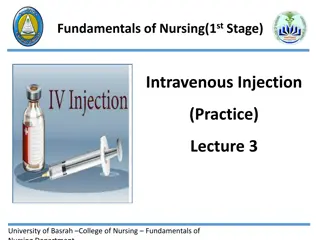Continuous Intravenous Multimodal Analgesia in Cesarean Section
This study compares the effectiveness of continuous intravenous fentanyl-ketorolac with single ketorolac bolus in managing pain for patients undergoing cesarean section. The research highlights the importance of proper pain management to prevent complications and improve patient outcomes.
Download Presentation

Please find below an Image/Link to download the presentation.
The content on the website is provided AS IS for your information and personal use only. It may not be sold, licensed, or shared on other websites without obtaining consent from the author.If you encounter any issues during the download, it is possible that the publisher has removed the file from their server.
You are allowed to download the files provided on this website for personal or commercial use, subject to the condition that they are used lawfully. All files are the property of their respective owners.
The content on the website is provided AS IS for your information and personal use only. It may not be sold, licensed, or shared on other websites without obtaining consent from the author.
E N D
Presentation Transcript
The use of continuous intravenous multimodal analgesia fentanyl- ketorolac in patients with cesarean section Ardi Pramono
Introduction If acute pain is not treated properly, it can lead to chronic pain, prolong hospitalization, thus increasing hospital costs, and ultimately reduce the satisfaction and comfort of patients (Garimella, and Cellini, 2013)
Two classes of analgesics: Opioids: Fentanyl Non-steroidal anti-inflammation drug (NSAID): Ketorolac
This study was to compare the use of multimodal analgesia techniques using a continuous intravenous fentanyl-ketorolac and single ketorolac bolus intermittent in caesarean section
The use either faction opioid analgesics or NSAIDs, can not effectively relieve pain without causing side effects such as nausea, vomiting, sedation, or bleeding (Jin and Chung, 2001).
Adding morphine to ketorolac has reduced the side effect and dose dependent of opioid (Maria et al, 2005)
Material and Method The subjects of this research were patients who underwent caesarean section at teaching hospital Asri Medical Center (AMC) and PKU Gamping Yogyakarta Divided into two groups: 20 subject in fentanyl and 20 subject in ketorolac group
In fentanyl group, the subjects were given a multimodal analgesic fentanyl-ketorolac, while in ketorolac group, were given bolus ketorolac as they feel pain (VAS score >5).
Dose Fentanyl group: Mix of 200ug dose of fentanyl and ketorolac 60 mg dissolved in aqua up to a volume of 100 ml, filled in syrinxjector, and supplied continuously at a rate of 5 cc / hour. All groups of subjects recorded how many people who require additional analgesic ketorolac in all groups
Result A combination analgesic fentanyl and ketorolac continuously can reduce pain in the majority of subject in 20 hours after caesarean compared with subject who received a single dose of ketorolac only (90%:0%)























